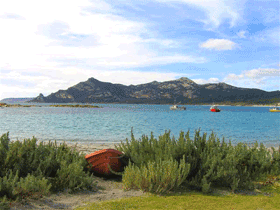|

Trouser Point
![]()
Strzelecki Range from Lady Barron
![]()
![]() Beach at Lady Barron Beach at Lady Barron
![]()
Mt. Strzelecki

Killiekrankie Bay
![]()
Lady Barron jetty
![]()
Whitemark township
|
Isolated, long, gleaming beaches, abundant wildlife in bushland, wetland, ocean and shore; all surrounded by outlying, uninhabited islands and of course, the shining, restless sea - that's what Flinders Island is all about.
Surrounded by over 50 mostly uninhabited islands, more than 65 shipwrecks and with over 120 pristine beaches, Flinders Island is a great place for a relaxing, rejuvenating holiday, being set amid the tranquillity of one of Australia's idyllic natural settings. Not many people live there, and not many people go there, so this is the place to be if you you don't want to share your holiday destination with the rest of Australia.
Tasmania's largest and Australia's 6th largest island, Flinders Island is located in Bass Strait, some 20 km from the north-eastern tip of Tasmania, Australia. It is the largest island of the Furneaux Group. Flinders is a long, narrow island, 75km long and 40km wide, with the Darling Ranges running along the middle of the island. With a height of 756m Mt. Strzelecki is the island's highest peak. The total land area of the island is 1.333 sq. km.
![]()
The Furneaux Group of islands is situated within the infamous Roaring Forties and coastal waters can be exposed to strong and variable winds and high seas all through the year. About a third of the islands are dominated by ridges of granite, including the striking features of the southern part of the Strzelecki Range, Darling Range, Mt. Killiekrankie, the Patriarchs (Flinders Island) and the higher parts of Cape Barren Island. Many of the islands in the Furneaux region are coastal sand dunes with related soil deposits. These form a broad plain on the eastern side of Flinders Island and a narrow strip on the west coast, with similar features on Cape Barren Island to the south.
Around 900 people live on the island, with farming and fishing being important industries. The farmers producing quality beef and lamb as well as clean fine wool and the fishermen harvesting crayfish, abalone, scallops and giant crabs. The major population centres are Whitemark (which has the island's main airstrip) and Lady Barron (the port).
A little over a third of the island is used for farmland, with the remainder being National Park. Bushland, lagoons and coastal reserves provide the visitor with a superb opportunity to explore and enjoy Flinders Island's little changed natural setting, with an abundance of wildlife and a fascinating history thrown in for good measure.
Flinders Island Trail: Back in the early seventies an ambitious project created the Flinders Trail running south to north of the island. The Trail included opportunities for horse riding, walking and four wheel driving. While the trail still exists some part are a challenge and need upgrading. Efforts are underway to bring the Trail back as a great outdoor experience and create another unique Flinders Island walk.
The Trail winds its way from the Strzelecki National Park to the North East River and provides the visitor with great walks across mountain ranges and along coastal beaches that include a variety of bird and animal life as well as different vegetation types.
There are opportunities to stop off and study the history or find a Killiecrankie Diamond or do a spot of fishing. Flinders Trail can be divided into five sections linked to accommodation at Lady Barron, Whitemark Emita, Killiecrankie and Palana. More >>
History: Flinders Island was first identified by Europeans when Tobias Furneaux, the commander of Captain Cook's support ship, became separated from the Endeavour in fog and discovered the Furneaux group of islands on 19th march 1773.
George Bass and Matthew Flinders, resolved the issue of Van Diemen's Land's status, when, between October 1798 and June 1799, they circumnavigated the island. The strait which separates Tasmania from the mainland was named after Bass and this, the major island, was named after Flinders by Governor King.
The first European settlers in the Furneaux group were sealers. The sealing industry started after the survivors of the Sydney Cove (wrecked at Preservation Island) reported large numbers of fur seal in the area.
![]()
Castle Rock, Trouser Point
The sealers that were left behind to harvest seals while the boats transported products from the seals back to markets often kidnapped Australian and Tasmanian Aboriginal women to work for them and become their wives. The last sealing licences were issued in 1828. After the collapse of the sealing industry a few of the sealers and their wives settled on the islands around the Furneaux group. These settlers leased the outer islands where they survived on grazing and mutton birding.
In 1833 the remnants of the Tasmanian Aboriginal population (a mere 160 people) were exiled to live at Settlement Point (named by the aboriginals as Wybalenna- black mans house's) on Flinders Island, with the misguided belief that they would be protected from the rape and abuses of the white settlers in Tasmania. By 1847 the settlement had been deemed as a failure and was abandoned; the remaining 45 Aborigines were sent to Oyster Cove on the east coast of Tasmania.
The first freehold land was selected in 1888 by George Boyes (31 acres at Palana) prior to this Flinders Island was leased to individual persons. The first council was elected in 1908 after which there was an increase in population mainly based on agricultural and fishing industries. In the early 1950s a soldier settlement scheme was initiated clearing and draining land on the east coast of Flinders Island, (approximately 33,559 hectares) this greatly increased the island's productivity. Settlers for this scheme mainly came for Tasmania and central New South Wales.
View Larger Map
|